After the Q4 2014 iteration of the Monogatari franchise, I must admit to being a bit worried. Luckily, on New Year’s Eve, Tsukimonogatari quelled my fear with a story all about consequences, character building and storytelling — all in the beautiful art style the series is known for.
Note: Tsukimonogatari is the sixth iteration of the Monogatari series. Thus, this review contains spoilers for the previous series. For a non-spoiler look at the franchise, check out our review of the first Monogatari anime, Bakemonogatari.
Good — Consequences
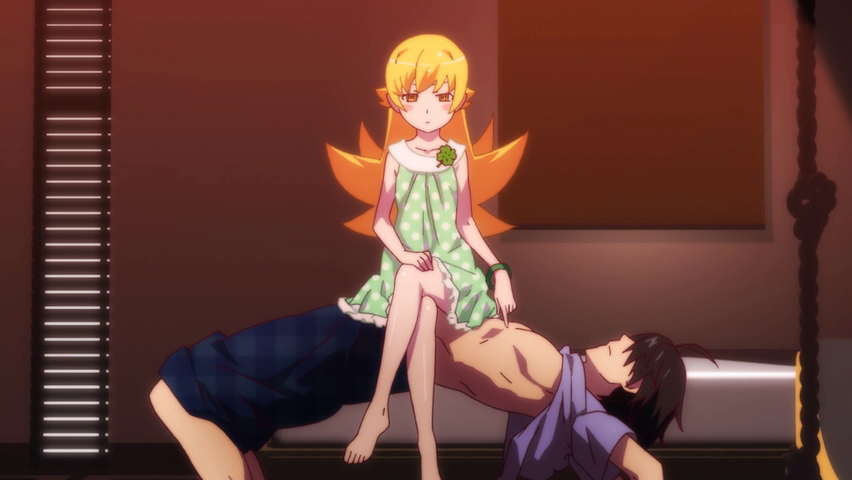
After the events of Mongatari Second Season, Araragi’s life seems to be returning to normal. He is studying for college entrance exams and spending time with his girlfriend. Until, of course, he notices that he has no reflection. Because of his repeated use of his remaining vampire powers throughout the various series thus far, he has started to become one in his own right. The only way to stop the transformation is to stop using his powers. However, he soon finds that events are already conspiring to test his resolve.
Tsukimonogatari is a story all about consequences. Up until this point in the anime series, Araragi has muddled through by just following his own innate sense of right and wrong. When a new problem arises, he confronts it head on as best he can. In Second Season, we saw other people, namely Mayoi and Nadeko, dealing with the consequences of his solutions to their previous problems. However, Tsukimonogatari is the first time we see Araragi himself directly affected by what he has been doing. Moreover, we learn what will likely happen to him should he go full vampire — and the large number of deaths that will likely result in a battle to take him down.
Good — Character Moments
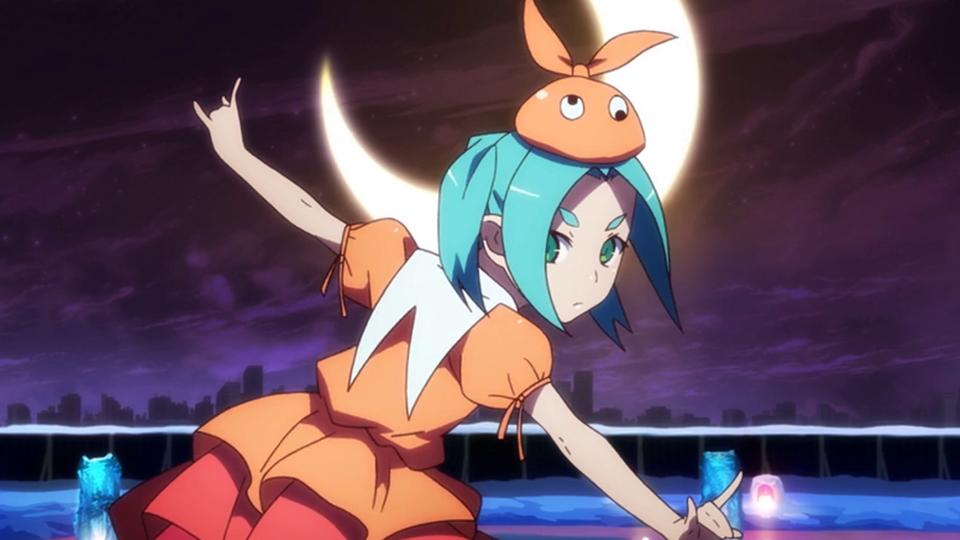
In facing this problem we learn more about the person Araragi is. We see he does not regret his actions but simply accepts them — along with the consequences. In fact, he sees much of what happens in Tsukimonogatari as a sort of divine retribution for his exploitation of his occult powers — even in the face of a much more likely and logical explanation. Moreover, what is really interesting is that immediately after learning the cure for his vampirism to it simply not use his vampire powers — and subsequently being forced to promise to do exactly that — Araragi readily admits to himself that should his family, Hanekawa, or Senjogahara be in danger, he’d use his powers regardless of the consequences to himself. It is interesting to see a character who knows his own flaws and simply accepts them instead of trying to change them, especially in light of the extreme negative consequences likely to happen.
But Araragi’s development isn’t the only good character moment we see. Ononoki plays a large role as the main companion of this section of the story. Despite looking human, she is a walking corpse — a weapon of sorts to be used in the killing of dangerous spirits. Yet, Araragi treats her as human — even going so far as to play along with her eccentricities (like sitting inside a crane game until someone wins her). The problem is, she isn’t human; she is literally a monster. And really, that’s the point of Tsukimonogatari: Araragi learning that lesson.
[Skip to the following section to avoid spoilers.] Another great character moment is near the end of the anime — the uplifting epilogue to the depressing climax. After returning home, Araragi, likely looking for emotional support, goes to his girlfriend’s house, only to discover that it is Valentine’s Day. After forcing him to down some chocolate and listening to his worries, she none-too-subtly initiates a more intimate encounter.
What’s great about this scene in the constantly running subtext. Araragi is clearly bothered by what has happened and Senjogahara is likewise concerned for him. But on the other hand, it is Valentine’s Day. Thus you can see Senjogahara’s warring emotional state. When he mentions telling her before Hanekawa, she is happy. But when he says he will see Hanekawa on his way home — i.e., see a girl other than his girlfriend on Valentine’s Day — she reacts as any insecure girl might and lets him know in no uncertain terms that he is hers for the day. It’s a cute moment that once again proves how nuanced of a character she is.
Good — A Story About Stories
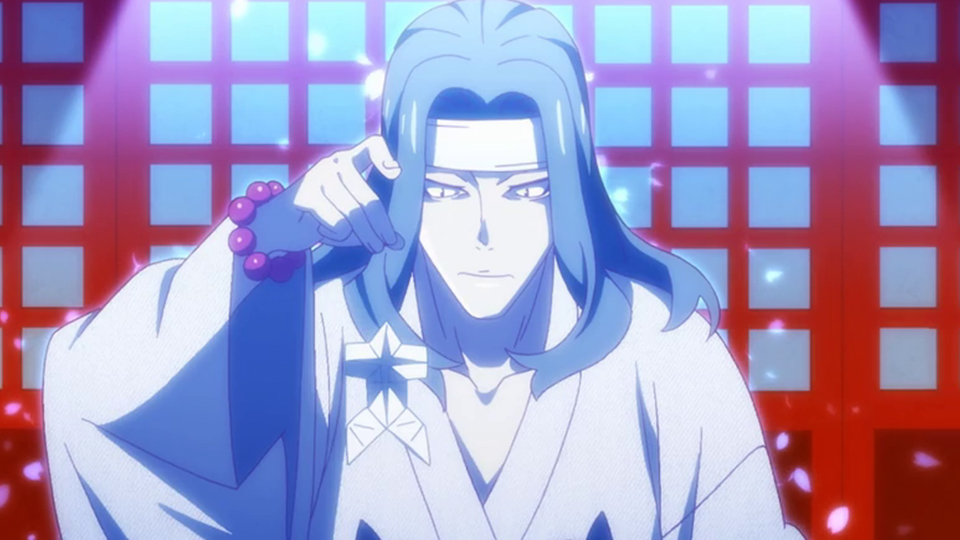
If you don’t speak Japanese, allow me to clue you in to the meaning of the franchise’s title: “monogatari” means “story.” So it shouldn’t surprise anyone, when it comes down to it, that the whole series is a story about stories — focusing on how they are told and playing around with oft used literary structure. Even in Tsukimonogatari itself the characters begin to look at the events happening in the story as if they were pre-scripted — they voice out loud that everything is unfolding as if in a story. Which, when you get right down to it, they are. After all, even ignoring that this is a work of fiction, Araragi himself is narrating the tale from some future date.
Good — Furthers the Meta-Plot
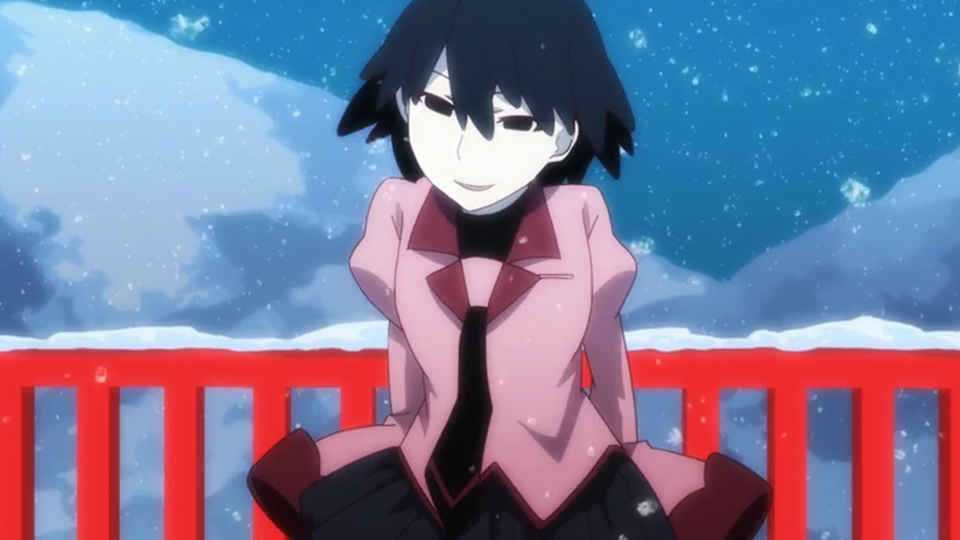
The question that comes from realising that everything is turning out like a story is “who is behind setting everything up for this conflict and why?” And thanks to the events of Tsukimonogatari, we are finally able to see the villain’s first major goal clearly: isolate Araragi. After all, during Monogatari Second Season, he loses two of his allies: Mayoi and Nadeko. In Tsukimonogatari, he arguably loses a third.
What makes the “evil plan” of Tsukimonogatari so interesting is the fact that it’s a Xanatos Gambit — a plan where no matter what happens, the villain wins. If Ononoki kills Teori, she will no longer be trusted by Araragi. If Araragi uses his vampire powers, most of his allies will be forced to turn against him. Heck, even if he does nothing, he still loses three allies. In the end, all the good guys can do is attempt to mitigate the damage.
Mixed — All Talk, No Action
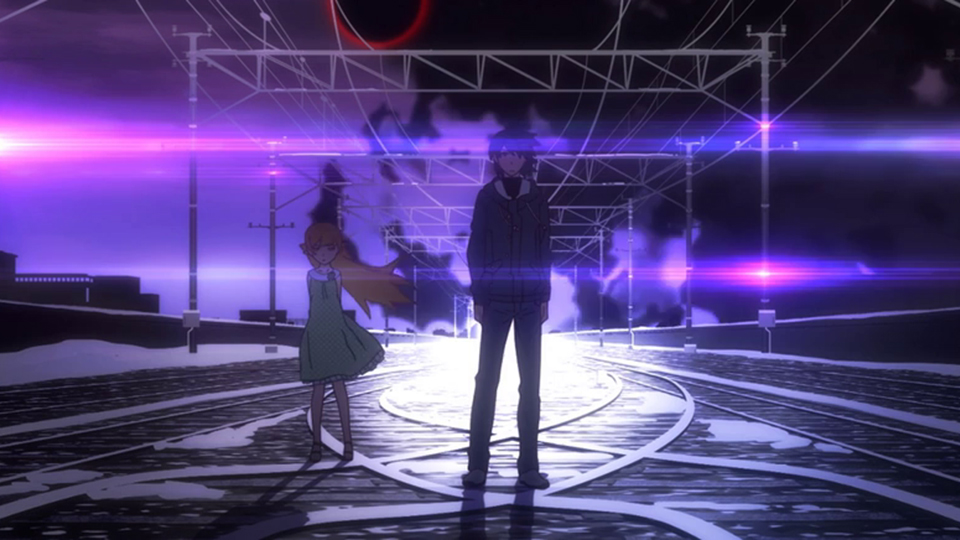
Like several chapters of the franchise, Tsukimonogatari is all talk, no action. Let’s be clear, though: All talk it may be, but it is some of the most visually appealing “non-action” I have ever seen. The various locations are colourful and deeply captivating in all their supernatural glory. Even if you are not interested in the conversations, the animation is so beautiful it’s almost worth watching on mute.
Of course, that’s not to say that the dialogue isn’t interesting — quite the opposite, actually. Everything falls into one of three categories: dialogue that furthers the meta-plot, dialogue that sets up or resolves the self-contained story of Tsukimonogatari, or dialogue of the humorous variety with no other purpose than comedy. The first two kinds of dialogue are great in Tsukimonogatari. They continue to develop the various characters, give new insight into the overall plot, and still deliver an immediate conflict where the resolution seems like it could go any of several ways. The comical dialogue (with one glaring exception) is likewise enjoyable. Still, if dialogue-heavy anime aren’t your thing, it likely doesn’t matter how good it looks or how well written it is.
Bad — Incestuous Fanservice Humour
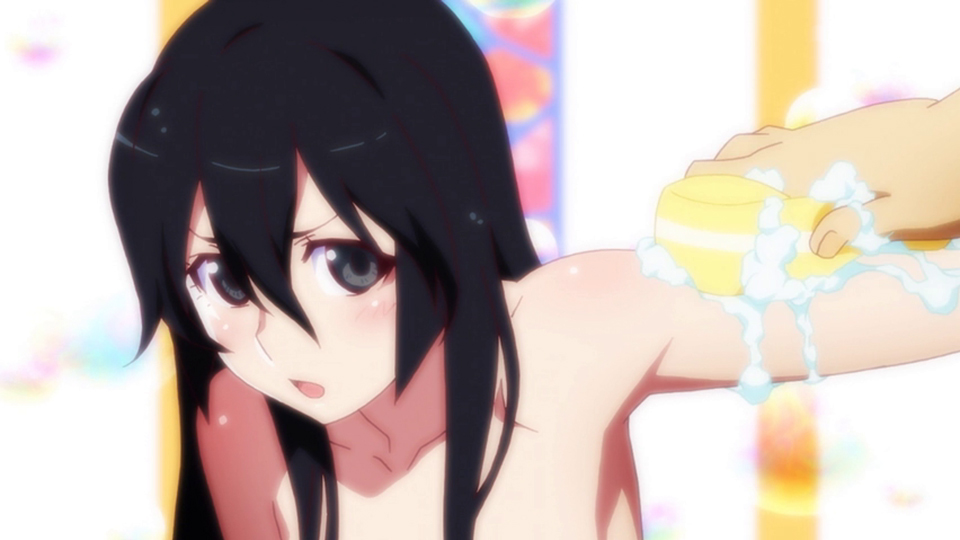
It’s unfortunate that, like Nisemonogatari before it, Tsukimonogatari will likely be remembered for its worst aspect — a scene laden with incestuous sexual tension. As in Nisemonogatari, Araragi refuses to back down from one of his sisters (the other one this time) and, as a result, ends up sharing the same cramped bath with her despite the fact that she is around 15 and him 18 — much too old to do this even by Japanese standards. What follows is their checking out each other in the nude before washing each other as they converse about how they are in no way embarrassed or titillated by what is going on — before, of course, ending up in a position where they are about to kiss.
The whole thing serves as both sexual fanservice and comedy likely meant to bring out the absurdity of this common brother/sister romantic anime trope. The problem is, these two aspects work at cross purposes. The fanservice in this scene is so extreme that it puts nearly everything short of anime pornography to shame and the attempts at awkward comedy are constantly being overshadowed by said visuals. To put it another way, the danger of mocking something and indulging in it lavishly at the same time is that your message will likely be either lost or seem more than a little hypocritical.
Final Thoughts
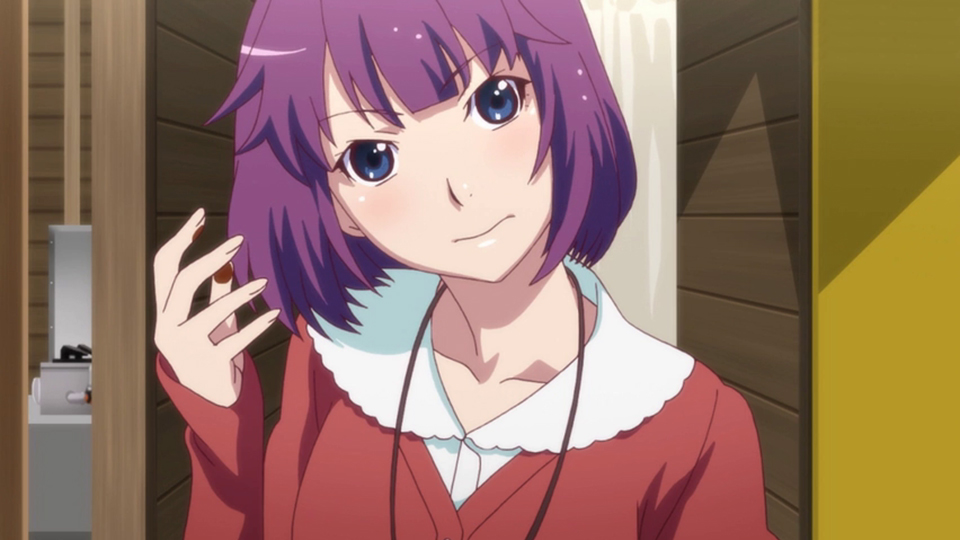
Tsukimonogatari is an excellent iteration of the series. For the first time in the franchise, Araragi finds himself as both the focal point of the supernatural occurrence and the person trying to solve it — all while dealing with the fact that what is happening is largely his fault. It also further develops both the overall story and the characters within in new and significant ways. Moreover, it’s just beautiful to watch. In the end, its only sticking point is the aforementioned bath scene; and if it’s a deal-breaker for you, well, no one will blame you.
Tsukimonogatari aired in Japan on December 31, 2014, on Animax. It can be viewed for free and with English subtitles in the US on Daisuki.
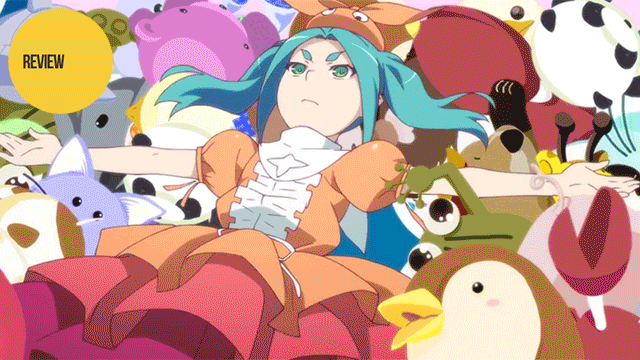
Comments
9 responses to “Tsukimonogatari Is 2014’s Last Good Anime”
Ugh… vampires
Last good, type b anime anime maybe, but I wouldnt know anyway. I Steer clear of of the monogatari series.
Enjoy Dragonball Z man! Yeeeewwww!
Seriously though, I just caught up on the last 2 Monogatari iterations and jumped on kotaku to see what others’ impressions of them are and you’re in both threads carrying on with the type A/B rot. I dunno about you but I tend to enjoy stuff on it’s own terms. I’ve been watching anime for about 20 years now and I really dislike how formulaic and pandering a lot of newer shows are but Monogatari has great characters and an utterly unique look and feel and to me at least that is mighty refreshing.
Or y’know, whatever.
I dunno, to me it always seemed like a harem where the characters have tons of conversations about puns for entire episodes and not much happens.
I’ve been wanting to get into the monogatari series, but when I tried watching the first episode of bakemonogatari, it felt like I was in the middle of the series. I was confused because there was nothing being explained.
The Monogatari series is very scattered in terms of story and does leave you wondering about several things for a lot of it, although that’s kind of one of its charms. It won’t be until you get near the end of Second Season that a lot of the blanks start getting filled in. Still, the trick is to not wonder about what happened, but focus on what is happening. The stories are still relatively self-contained despite the dangling threads.
I’ll give it another go. Hopefully I’ll be able to atleast understand the beginning of the episode.
I loved Bakemonogatari, then I watched Nisemonogatari and hated it, should I keep going with the series? Does it get good again? Surely they must keep making it for a reason.
Monogatari Second Season is worth it. Its pretty powerful, way better than the awkwardness that was Nisemonogatari. I haven’t watched Hanamonogatari yet though, so I cant comment on that one.